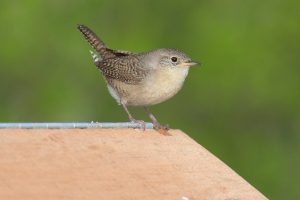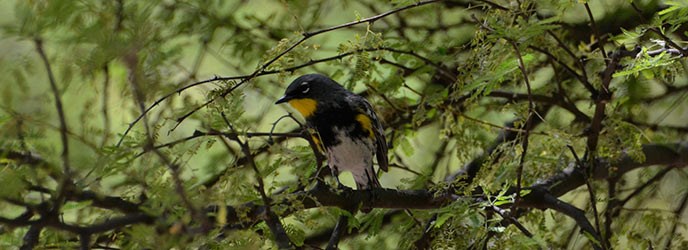Texas Hill Country Birds
Texas has a wide variety of bird species, many of which may be found in the Texas Hill Country.
There are only two species for which the Texas Hill Country is regarded as the only/best place to see them in large numbers. The Black-capped Vireo and the Golden-cheeked Warbler. But there are some of the birds on most visitors’ “wish lists.” The Texas Hill Country is a great place to see them because they’re plentiful and widespread. They are regulars among locals, but most visitors can’t get enough of them.
Cuckoos
Yellow-billed Cuckoo (Coccyzus americanus)
The Yellow-billed Cuckoo is a cuckoo. Common folk names for this bird in the southern United States are Rain Crow and Storm Crow. These likely refer to the bird’s habit of calling on hot days, often presaging thunderstorms. Adults have a long tail, brown above and black-and-white below, and a black curved bill with yellow especially on the lower mandible. The head and upperparts are brown and the underparts are white. There is a yellow ring around the eye. It shows cinnamon on the wings in flight. Juveniles are similar, but the black on the undertail is replaced by gray. Their build is Slender and long-tailed with plumage is grayish-brown above and white below, with red primary flight feathers.

Like other cuckoos, they have two forward-facing toes and two backward-facing toes.
Roadrunner
The roadrunners are two species of bird in the genus Geococcyx of the cuckoo family, Cuculidae, native to North and Central America. These two species are the ground foraging cuckoos. the Roadrunner The roadrunner is a large, slender, black-brown and white-streaked ground bird with a distinctive head crest.
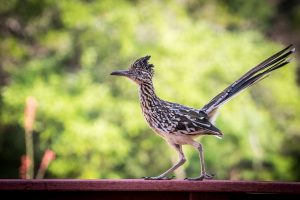
The tail is broad with white tips on the three outer tail feathers. The roadrunner generally ranges in size from 56 to 61 cm
Cranes in Texas Hill Country
Sandhill Crane
The Sandhill Crane has a long necks and legs, with an impressive wingspans and long pointed beaks. They are North America and extreme northeastern Siberia. The common name of this bird references habitat like that at the Platte River, on the edge of Nebraska’s Sandhills in the American midwest. Sandhill Cranes are similar in plumage across their range, but they vary in size. Sandhill cranes spend most of their lives in freshwater wetlands, including marshes, wet grasslands and river basins.
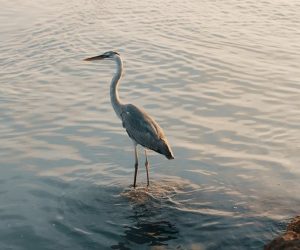
The omnivorous Sandhill Crane usually feeds on land or in shallow marshes in the coast of Texas where plants grow out of the water, gleaning from the surface and probing with its bill. The Sandhill Crane’s diet consists of cultivated grains, and can also include berries, tubers, small vertebrates, and invertebrates.
Whooping Crane (Grusamericana)
Named for its whooping sound, the whooping crane (Grus americana), is the tallest North American bird. The Whooping Crane, the tallest North American bird, is an endangered crane species named for its whooping sound and call. Along with the Sandhill Crane, it is one of only two crane species found in North America. The whooping crane’s lifespan is estimated to be 22 to 24 years in the wild. There is an estimate of only 400+ left in the wild.
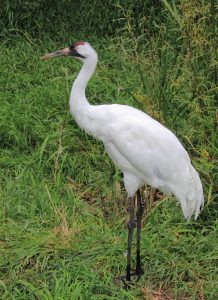
Whooping cranes have a long live span – current estimates suggest maximum longevity in the wild of at least 30 years.
Texas Hill Country Doves
Inca Dove (Columbina inca)
The Inca Dove is a small New World dove; it might belong to the genus Columbina. It ranges from the southwestern United States and Mexico through Central America to Costa Rica; the Inca Dove only lives on the Pacific side of Central America.
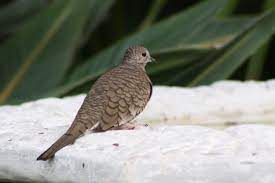
Credit: Kati Fleming
Mourning Dove
The Mourning Dove is a member of the dove family. The bird is also called the Western Turtle Dove or the American Mourning Dove or Rain Dove and formerly was known as the Carolina pigeon or Carolina Turtledove. It is one of the most abundant and widespread of all North American birds.

Credit: wikipedia
Rock Pigeon (Columba Olivia)
The Rock Pigeon, or Rock Dove, is a member of the bird family Columbidae. In common usage, this bird is often simply referred to as the “pigeon”. The species includes the domestic pigeon (including the fancy pigeon), and escaped domestic pigeons have given rise to the Feral Pigeon.
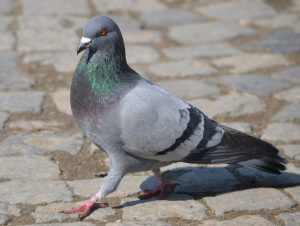
Credit: Wikipedia
White-winged Dove
The White-winged Dove is a dove whose native range extends from the south-western USA through Mexico, Central America and the Caribbean. It has also been introduced to Florida.
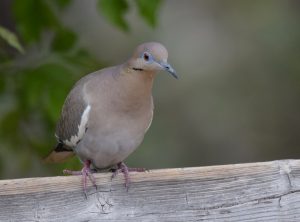
Credit: Wikipedia
Ducks in Dripping Springs
Black-bellied Whistling Duck
The Black-bellied Whistling-duck, formerly also called Black-bellied Tree Duck, is a whistling duck that breeds from the southernmost United States and tropical Central to south-central South America. In the USA, it can be found year-round in parts of southeast Texas, and seasonally in southeast Arizona, and Louisiana’s Gulf Coast. It is a rare breeder in such disparate locations as Florida, Arkansas, Georgia, and South Carolina.
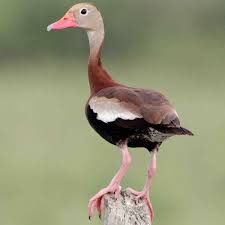
Credit Wikipedia
Bufflehead (Bucephala albeola)
The Bufflehead is a small American sea duck of the genus Bucephala, the goldeneyes. This species was first described by Linnaeus in his Systema naturae in 1758 as Anas albeola.

Canvasback
The Canvasback is a large North American diving duck, that ranges from between 48–56 cm long and weighs approximately 862-1588 g, with a wingspan of 79-89 cm. The adult male has a black bill, a chestnut red head, and neck, a black breast, a grayish back, a black rump, and a blackish-brown tail.
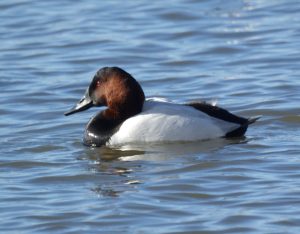
Credit: Wikipedia
Coot
Coots are medium-sized water birds which are members of the rail family. Coots have predominantly black plumage, and, unlike many of the rails, they are usually easy to see, often swimming in open water. They are close relatives of the moorhen.
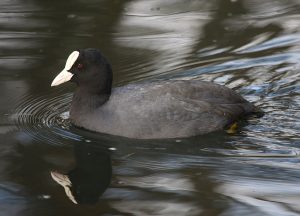
Mallard
The Mallard, or Wild duck, probably the best-known and most recognizable of all ducks, is a dabbling duck that breeds throughout the temperate and sub-tropical America, Europe, Asia, New Zealand (where it is currently the most common duck species), and Australia.
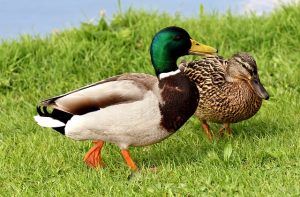
Credit: Wikipedia
Muscovy Duck (Cairinamoschata)
The Muscovy Duck is a large duck that is native to Mexico and Central and South America. A small wild population reaches into the United States in the lower Rio Grande Valley of Texas. There also are feral breeding populations in North America in and around public parks in nearly every state of the USA and in the Canadian provinces. Feral populations also exist in Europe. Although the Muscovy Duck is a tropical bird, it adapts to icy and snowy conditions down to 10°F and below without ill effects.
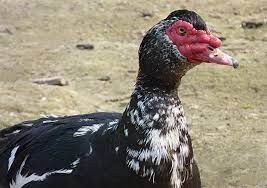
Credit: Wikipedia
Teal
The Common Teal or Eurasian Teal is a common and widespread duck that breeds in temperate Eurasia and migrates south in winter. It is the Old World counterpart of the North American Green-winged Teal, which was formerly (and sometimes is still) considered a subspecies of A. crecca. The Common Teal is often simply called “the teal” due to being the only one of these small dabbling ducks in much of its range. The blue-green color teal was named for it.
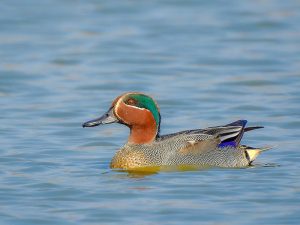
Wood Duck
The Wood Duck or Carolina Duck is a medium-sized perching duck found in North America. It is considered by some the most beautiful of all North American waterfowl, if not the world
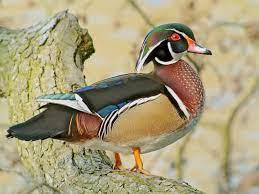
Eagles in Dripping Springs
Bald Eagle (Haliaeetusleucocephalus)
The Bald Eagle is a bird of prey found in North America. It is the national bird and symbol of the United States of America. This sea eagle has two known sub-species and forms a species pair with the White-tailed Eagle. Its range includes most of Canada and Alaska, all of the contiguous United States, and northern Mexico. It is found near large bodies of open water with an abundant food supply and old-growth trees for nesting.

Credit: Wikipedia
Golden Eagle
The Golden Eagle is one of the best-known birds of prey in the Northern Hemisphere. Like all eagles, it belongs to the family Accipitridae. Once widespread across the Holarctic, it has disappeared from many of the more heavily populated areas. Despite being locally extinct or uncommon, the species is still fairly ubiquitous, being present in Eurasia, North America, and parts of Africa. The highest density of nesting Golden Eagles in the world lies in southern Alameda County, California.

Credit: Wikipedia
Southern Caracara
The Southern Caracara, also known as the Southern Crested Caracara, is a bird of prey in the family Falconidae. It formerly included the Northern Caracara of the southern United States, Mexico, Central America and northern South America. As presently defined, the Southern Caracara is restricted to Southern Texas, central and southern South America.
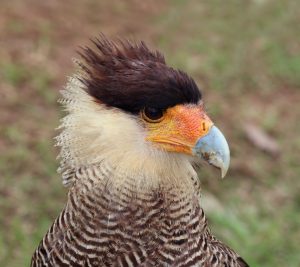
Credit: Wikipedia
Texas Hill Country Egrets
Reddish Egret (Egrettarufescens)
The Reddish Egret is a small heron, and a resident breeder in Central America, The Bahamas, the Caribbean, the Gulf Coast of the United States, and Mexico. There is post-breeding dispersal to well north of the nesting range. In the past, this bird was a victim of the plume trade.
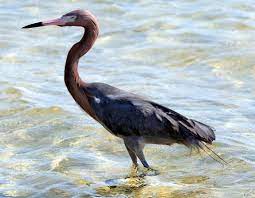
Credit: Wikipedia
According to the Texas Parks and Wildlife Department, there are only 1,500 to 2,000 nesting pairs of Reddish Egrets in the United States – and most of these are in Texas. They are classified as “threatened” in Texas and receive special protection.
Falcons in TX Hill Country
American Peregrine Falcon (Falco peregrinus anatum)
The Peregrine Falcon, also known as the Peregrine,and historically as the “Duck Hawk” in North America, is a cosmopolitan bird of prey in the family Falconidae. It is a large, crow-sized falcon, with a blue-gray back, barred white underparts, and a blackhead and “moustache”. It can reach speeds over 200 mph in a stoop,making it one of the fastest creatures on the planet. As is common with bird-eating raptors, the female is much bigger than the male.
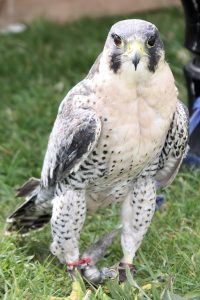
Credit: Wikipedia
Arctic Peregrine Falcon (Falcoperegrinus tundrius)
The Tundra Peregrine is the palest of the North American subspecies, and also is slightly smaller than the others. Adults have an almost unmarked white breast, and relatively light barring across their mostly white belly. Their back is slate-colored with bluish-gray tinges and may take on a silvery appearance, especially lower on the back.
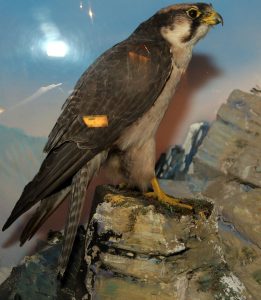
Credit: Wikipedia
The mustache on Tundra Peregrines is very narrow, and the white auricular patch (the area behind the mustache) is large. Immatures often have a pale buff or whitish crown and forehead and have a pale superciliary line (over and behind the eye). Their breast is finely streaked, with a cream-colored background. The brown back feathers have wide buffy edges to them.
Northern Aplomado Falcon (Falco femoralis)
The Aplomado Falcon is a medium-sized falcon of the Americas. The species’ largest contiguous range is in South America, but not in the deep interior Amazon Basin. It was long known as Falcofusco-coerulescens or Falco fuscocaerulescens, but these names are now believed to refer to the Bat Falcon.
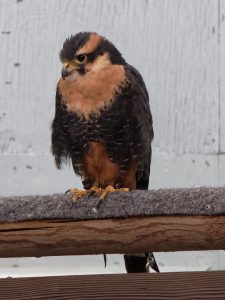
Credit:Zruda
Its resemblance in shape to the hobbies accounts for its old name Orange-chestedHobby. Aplomado is an unusual Spanish word for “lead-colored”, referring to the blue-grey areas of the plumage – an approximate English translation would be “leaden falcon”.
Texas Hill Country Flycatchers
Common Nighthawk
The Common Nighthawk is a species of nightjar that is native to the Americas. The adults have brown feathers with some darker ones too (some black feathers), gray and white patterning on the upper parts and breast. The long wings are black and reveal a white bar when in flight. The tail is dark with white barring and the underparts are white with black bars. The adult male has a white throat while the female has a light brown throat. They measure 8.7–9.4 inches in length, have a 21–22 inch wingspan, and weigh 2.3–3.5 ounces.
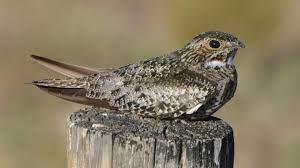
Credit: Wikipedia
Purple Martin
The Purple Martin is the largest North American swallow. These aerial acrobats have speed and agility in flight, and when approaching their housing, will dive from the sky at great speeds with their wings tucked.
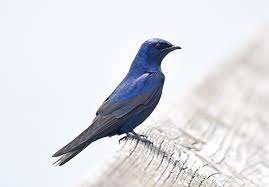
Credit: Wikipedia
Scissor-tailed Flycatcher (Tyrannus forficatus)
The Scissor-tailed Flycatcher is a long-tailed insect-eating bird closely related to the kingbirds found in North and Central America. Young birds are the same, but have a shorter tail and lack bright pink on the sides and on their belly area. These birds are especially numerous in southern part of Texas and may also be seen on fence posts or wires along the roadside.
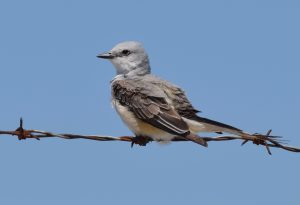
Credit: Wikipedia
Vermilion Flycatcher
The Vermilion Flycatcher is a small passerine bird that can be found in the southwestern United States, Central America, and northern and central South America, and southwards to central Argentina; also in the Galapagos Islands. This is the only species in the genus Pyrocephalus.
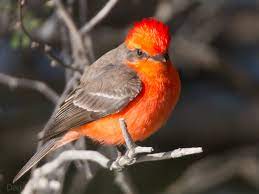
Credit: Dan Pancamo
Western Kingbird
The Western Kingbird is a large tyrant flycatcher. Adults are grey-olive on the upper parts with a grey head and a dark line through the eyes; the underparts are light becoming light orange-yellow on the lower breast and belly. They have a long black tail with white outer feathers. Western kingbirds also have a reddish crown that they only display during courtship and confrontations with other species.
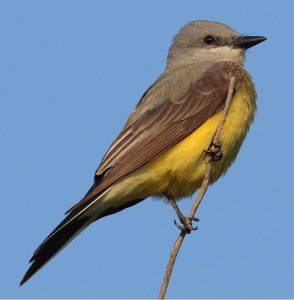
Whip-poor-will
The Whip-poor-will or Whippoorwill is a medium-sized nightjar from North and Central America. The Whip-poor-will is commonly heard within its range, but less often seen. It is named onomatopoeically after its call. The bird is sometimes confused with the related Chuck-will’s-widow which has a similar but lower-pitched and slower call. Adults have mottled plumage: the upper arts are grey, black, and brown; the lower parts are grey and black. They have a very short bill and a black throat. Males have a white patch below the throat and white tips on the outer tail feathers; in the female, these parts are light brown.
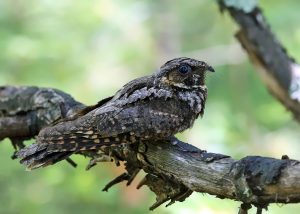
Geese in Texas Hill Country
Canada Goose
The Canada Goose is a wild goose belonging to the genus Branta, which is native to arctic and temperate regions of North America, having a black head and neck, white patches on the face, and a brownish-gray body. It is often called the Canadian Goose, but that name is not the ornithological standard or the most common name.

Ross’s Goose
The Ross’s Goose is a North American species of goose. This goose breeds in northern Canada, mainly in the Queen Maud Gulf Migratory Bird Sanctuary, and winters much further south in the continent in the southern USA and occasionally northern Mexico. The plumage of this species is white except for black wingtips. It is similar in appearance to a white-phase Snow Goose but approximately 40% smaller. Other differences from the Snow Goose are that Ross’s bill is smaller in proportion to its body and lacks “black lips”. The dark phase is extremely rare.
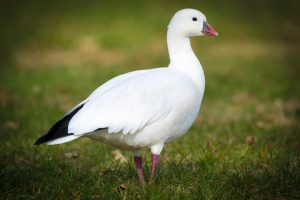
Snow Goose
The Snow Goose, also known as the Blue Goose, is a North American species of goose. Its name derives from the typically white plumage. This goose breeds north of the timberline in Greenland, Canada, Alaska, and the northeastern tip of Siberia, and winters in warm parts of North America from southwestern British Columbia through parts of the United States to Mexico.
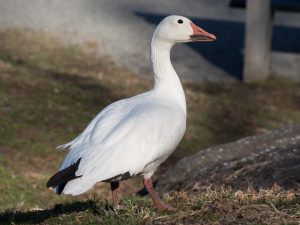
Texas Hill Country Hawks
Ferruginous Hawk (Buteoregalis)
The Ferruginous Hawk is a large bird of prey. It is not a true hawk-like sparrowhawks or goshawks but rather belongs to the broad-tailed buteo hawks, known as “buzzards” in Europe.
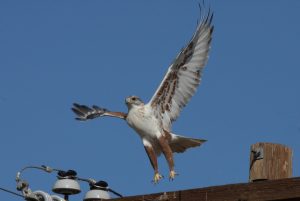
Red-shouldered Hawk (Buteolineatus)
The Red-shouldered Hawk is a medium-sized hawk. Its breeding range spans eastern North America and along the coast of California and northern to northeastern-central Mexico.
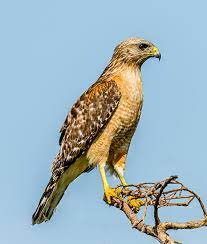
Red-tailed Hawk
The Red-tailed Hawk is a bird of prey, one of three species colloquially known in the United States as the “chickenhawk,” though it rarely preys on chickens[citation needed]. It breeds throughout most of North America, from western Alaska and northern Canada to as far south as Panama and the West Indies, and is one of the most common buteos in North America. Red-tailed Hawks can acclimate to all the biomes within their range.

Swainson’s Hawk (Buteoswainsoni)
The Swainson’s Hawk. This species was named after William Swainson, a British naturalist. It is colloquially known as Grasshopper Hawk or Locust Hawk, as it is very fond of locusts and grasshoppers and will voraciously eat these insects whenever they are available.
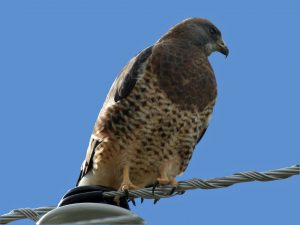
Herons in Texas
Black-crowned Night-heron (Nycticorax nycticorax)
The Black-crowned Night-Heron commonly abbreviated to just Night Heron in Eurasia, is a medium-sized heron found throughout a large part of the world, except in the coldest regions and Australasia (where replaced by the closely related Rufous Night Heron, with which it has hybridized in the area of contact).
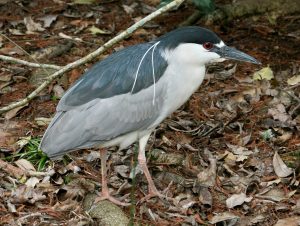
Great Blue Heron
The Great Blue Heron is a large wading bird in the heron family Ardeidae, common near the shores of open water and in wetlands over most of North and Central America as well as the West Indies and the Galápagos Islands.

It is a rare vagrant to Europe, with records from Spain, the Azores and England. An all-white population found only in the Caribbean and south Florida was once known as a separate species, the Great White Heron.
Hummingbirds in Dripping Springs
Texas is home to nine different hummingbird species. Austin, Texas, is an excellent location for observing hummers. Texas Hill Country Hummingbirds put on a spectacular show as they whir, bob, and zip from flower to flower and feeder to feeder.
Anna’s Hummingbird
Anna’s Hummingbird is a medium-sized hummingbird native to the west coast of North America. This bird was named after Anna Masséna, Duchess of Rivoli.
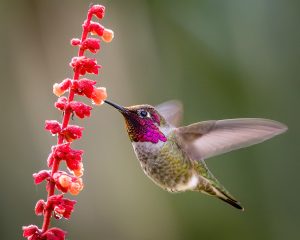
Black-chinned Hummingbird (Archilochus alexandri)
The Black-chinned Hummingbird is a small hummingbird. Adults are metallic green above and white below with green flanks. Their bill is long, straight and very slender. The adult male has a black face and chin, a glossy purple throat band and a dark forked tail. The female has a dark rounded tail with white tips and no throat patch; they are similar to female Ruby-throated Hummingbirds
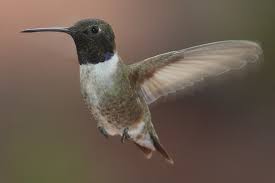
Buff-bellied Hummingbird (Amazilia yucatanensis)
The Buff-bellied Hummingbird is a medium-sized hummingbird. It is 3.9–4.3 in long and has a mass of 0.14–0.18 oz. Adults are a metallic olive green above and buffy in the lower breast. The tail and primary wings are rufous in color and slightly forked. The underwing is white.
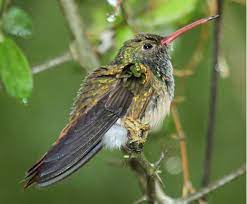
The bill of the male is straight and very slender. It is red in coloration with a darker tip. The throat is a metallic golden green. The female has a dark upper bill, and is less colorful than the male.
Ruby-throated Hummingbird (Archilochus colubris)
The Ruby-throated Hummingbird is a small hummingbird. It is the only species of hummingbird that regularly nests east of the Mississippi River in North America.The Ruby-throated Hummingbird is metallic green above and greyish white below, with near-black wings. Their bill is long, straight and very slender. The adult male has a ruby red throat patch which may appear black in some lighting, and a dark forked tail.
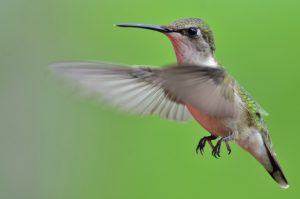
The female has a dark rounded tail with white tips and generally no throat patch, though she may sometimes have a light or whitish throat patch. The male is smaller than the female, and has a slightly shorter beak. A molt of feathers occurs once per annum, and begins during the autumn migration.
Ibis in Texas Hill Country
White-faced Ibis (Plegadischihi)
The White-faced Ibis is a wading bird in the ibis family. This species breeds colonially in marshes, usually nesting in bushes or low trees. Its breeding range extends from the western USA south through Mexico, as well as from southeastern Brazil and southeastern Bolivia south to central Argentina, and along the coast of central Chile. Its winter range extends from southern Californiaand Louisiana south to include the rest of its breeding range.
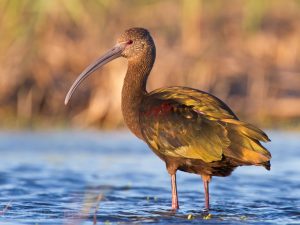
Texas Hill Country Jays
Blue Jay (Cyanocitta cristata)
The Blue Jay is a passerine bird, and a member of the family Corvidae native to North America. It belongs to the “blue”, Canadian or American jays, which are, among the Corvidae, not closely related to other jays. It is adaptable, aggressive and omnivorous, and has been colonizing new habitats for many decades.

Scrub Jay
The Western Scrub Jay is a species of scrub-jay native to western North America. It ranges from southern Washington to central Texas and central Mexico. The Western Scrub-Jay is nonmigratory and can be found in urban areas, where it can become tame and will come to bird feeders.
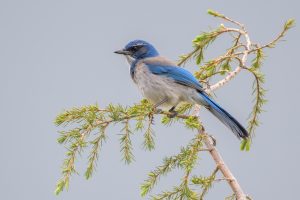
While many refer to scrub-jays as “blue jays”, the Blue Jay is a different species of bird entirely. In recent years, the California Scrub-Jay has expanded its range north into the Puget Sound region of Washington.
Owls in Texas Hill Country
Barn Owl
The Barn Owl is the most widely distributed species of owl, and one of the most widespread of all birds. It is also referred to as Common Barn Owl, to distinguish it from other species in the barn-owl family Tytonidae.

These form one of two main lineages of living owls, the other being the typical owls. It is found almost anywhere in the world except polar and desert regions, Asia north of the Alpide belt, most of Indonesia, and the Pacific islands
Burrowing Owl (Athenecunicularia)
The Burrowing Owl is a small, long-legged owl found throughout open landscapes of North and South America. Burrowing owls can be found in grasslands, rangelands, agricultural areas, deserts, or any other dry, open area with low vegetation. They nest and roost in burrows, such as those excavated by prairie dogs.
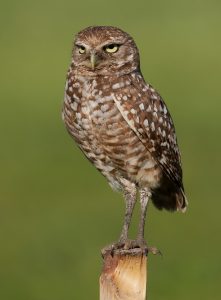
Unlike most owls, burrowing owls are often active during the day, although they tend to avoid the mid-day heat. Most hunting is still done from dusk until dawn, like many owls, when they can use their night vision and hearing to their advantage.
Eastern Screech-Owl (Megascops asio)
The Eastern Screech Owl or Eastern Screech-Owl is a small owl. Adults range from 6.3-9.8 inches in length. They have either rusty or dark gray intricately patterned plumage with streaking on the underparts. Small and stocky, short-tailed and broad-winged, they have a large round head with ear tufts, yellow eyes and a yellowish bill.
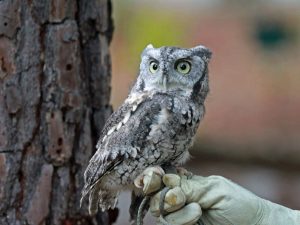
Rusty birds are more common in the southern parts of the range; pairings of the two color variants do occur. A pale gray variation also exists in western Canada and the north-central United States.
Elf Owl (Micrathene whitneyi)
The Elf Owl breeds in the southwestern United States and Mexico. It is the world’s smallest owl, followed closely by the Pygmy owl. They are 5-12 inches tall and have a wingspan of 15-16 inches and short tails. Their primary projection extends nearly past their tail. They have fairly long legs and often appear bow-legged.
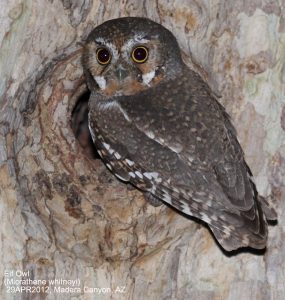
They weigh 1-1.4 ounces.They can often be heard just after dusk or at sunset, calling to each other. Their call is a high pitched whinny or chuckle. The male and female dart around trees and call back and forth.
Mexican Spotted Owl (Strixoccidentalis lucida)
The Spotted Owl is a species of true owl. It is a resident species of forests in western North America, where it nests in tree holes, old bird of prey nests, or rock crevices. Nests can be between 13 and 66 yards high and usually contain two eggs, though some will contain as many as four. It is a strictly nocturnal owl, which feeds on small mammals and birds.
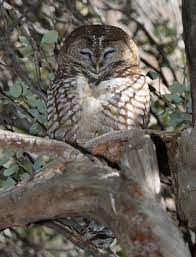
Chukar (Alectoris chukar)
The Chukar Partridge is an Eurasian upland gamebird in the pheasant family. This partridge has well marked black and white bars on the flanks and a black band running from the forehead across the eye and running down the head to form a necklace that encloses a white throat.
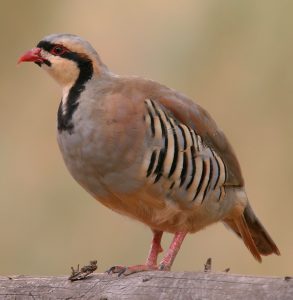
The species has been introduced into many other places and feral populations have established themselves in parts of North America and New Zealand. It is the national bird of Pakistan.
Dripping Springs Prairie Chicken
Attwater’s Prairie Chicken (Tympanuchus cupidoattwateri)
Attwater’s Prairie Chicken is a highly endangered subspecies of Greater Prairie Chicken. Over a century ago, one million Attwater’s Prairie Chickens graced the Western Gulf coastal grasslands of Texas and Louisiana. Today, less than 1% of their native coastal grassland habitat remains and in 1998 it was estimated that only 260 remained.
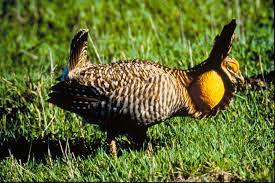
The Attwater’s Prairie Chicken measures 17-18 inches and weighs roughly 1.5 to 2 pounds. It has a 28 inch wingspan. These grouse-like ground birds have strong vertical bars of dark brown and buff-white in a zebralike pattern over the mantle, flanks, and underparts.
Quail in Texas Hill Country
Blue Quail
The Blue Quail or African Blue Quail is a species of bird in the Phasianidae family. The species ranges from Sierra Leone to Ethiopia, and south to Zambia, and eastward to Kenya, and is migratory. The habitat of the Blue Quail excludes excessively dry areas.
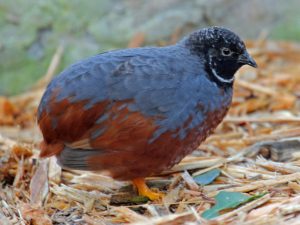
Bobwhite Quail
The Northern Bobwhite, Virginia Quail or (in its home range) Bobwhite Quail is a ground-dwelling bird native to the United States, Mexico, and the Caribbean. It is a member of the group of species known as New World quails.
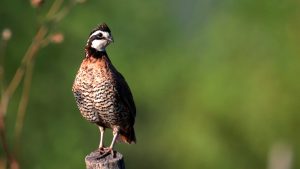
They were initially placed with the Old World quails in the pheasant family, but are not particularly closely related. The name “bobwhite” derives from its characteristic whistling call.
Texas Hill Country Raptors
American Kestrel (Falcosparverius)
The American Kestrel, sometimes colloquially known as the Sparrow Hawk, is a small falcon found in the Western Hemisphere. It is found in a variety of habitats throughout North and South America. At 7–8 inches long, it is the smallest falcon in North America. It exhibits sexual dimorphism with size and plumage, although both genders have a rufous back with noticeable barring. Juveniles are similar to the adults.
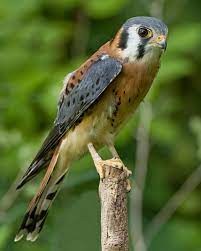
Mississippi Kite (Ictiniamississippiensis)
The Mississippi Kite is a small bird of prey. It is 12 to 14 inches long, beak to tail, and has a wingspan averaging 3 feet. Adults are gray with darker gray on their tail feathers and outer wings and lighter gray on their heads and inner wings. Males and females look alike, but the males are slightly paler on the head and neck.
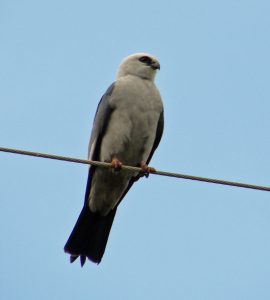
Northern Harrier (Circus cyaneus)
The Hen Harrier or Northern Harrier is a bird of prey. It breeds throughout the northern parts of the northern hemisphere in Canada and the northernmost USA, and in northern Eurasia.
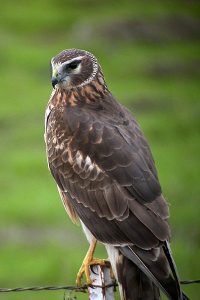
Scavengers in Dripping Springs
Crow
The true crows are large passerine birds that form the genus Corvus in the family Corvidae. Ranging in size from the relatively small pigeon-sized jackdaws to the Common Raven of the Holarctic region and Thick-billed Raven of the highlands of Ethiopia, the 40 or so members of this genus occur on all temperate continents (except South America) and several offshore and oceanic islands (including Hawaii). In the United States and Canada, the word “crow” is used to refer to the American Crow. The crow is a year-round species.
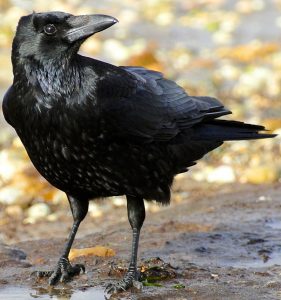
Raven
Raven is the common name given to several larger-bodied members of the genus Corvus—but in Europe and North America, the Common Raven is normally implied.
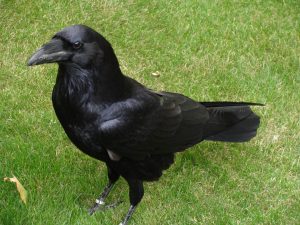
Shorebirds in Texas
American Avocet (Recurvirostra americana)
The American Avocet is a large wader in the avocet and stilt family. This avocet has long, thin, gray legs, giving it its colloquial name, “blue shanks”. The plumage is black and white on the back with white on the underbelly. The neck and head are cinnamon colored in the summer and gray in the winter. The long, thin bill is upturned at the end. The adult is about 18 inches tall.
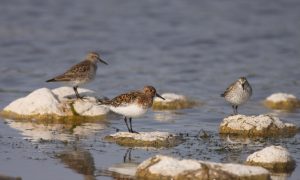
American Oystercatcher (Haematopus palliatus)
The American Oystercatcher, occasionally called the American Pied Oystercatcher, is a member of family Haematopodidae. The bird is marked by its black and white body and a long, thick orange beak. This shorebird is approximately 19 inches in length.
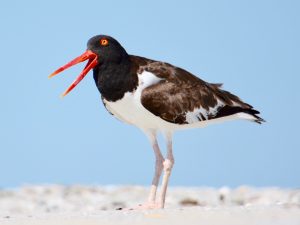
Black-necked Stilt (Himantopus mexicanus)
The Black-necked Stilt is a locally abundant shorebird of American wetlands and coastlines. It is found from the coastal areas of California through much of the interior western United States and along the Gulf of Mexico as far east as Florida, then south through Central America and the Caribbean to NW Brazil SW Peru, E Ecuador and the Galápagos Islands.
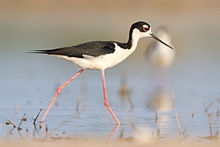
The northernmost populations, particularly those from inland, are migratory, wintering from the extreme south of the USA to southern Mexico, rarely as far south as Costa Rica; on the Baja California peninsula it is only found regularly in winter.
Eastern Brown Pelican (Pelecanus occidentalis)
The Brown Pelican is the smallest of the eight species of pelican, although it is a large bird in nearly every other regard. It is 42–54 inches in length, weighs from 6-12 lb.and has a wingspan from 6 to 8.2 feet. The Brown Pelican occurs on coasts in the Americas from Washington and Virginia south to northern Chile and the mouth of the Amazon River, as well as the island of Sautd’Eau in Trinidad and Tobago.
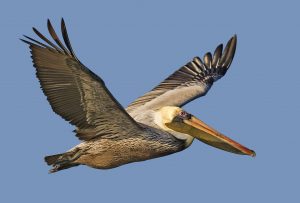
Some immature birds may stray to inland freshwater lakes. After nesting, North American birds move in flocks further north along the coasts, returning to warmer waters for winter.
Eskimo Curlew (Numeniusborealis)
The Eskimo Curlew or Northern Curlew (Numenius borealis) is a medium-sized New Worldshorebird. It is severely endangered and could possibly be extinct.
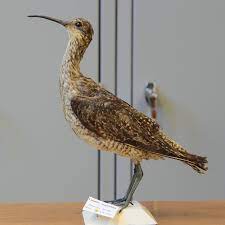
Interior Least Tern (Sterna antillarum athalassos)
The Least Tern is a species of tern that breeds in North America and locally in northern South America. It is closely related to, and was formerly often considered conspecific with, the Little Tern of the Old World. Other close relatives include the Yellow-billed Tern and Peruvian Tern, both from South America.
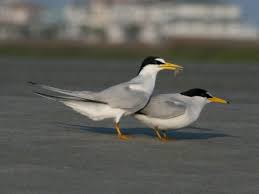
It is a small tern, 22–24 cm long, with a wingspan of 50 cm, and weighing 39–52 g. The upperparts are a fairly uniform pale gray, and the underparts white. The head is white, with a black cap and line through the eye to the base of the bill, and a small white forehead patch above the bill.
Long-billed Curlew (Numeniusamericanus)
The Long-billed Curlew is a large North American shorebird of the family Scolopacidae. This species was also called “sicklebird” and the “candlestick bird”. The species is native to central and western North America. In the winter, the species migrates southwards, as well as towards the coastline.
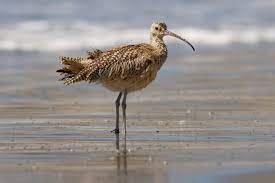
Adults have a very long bill curved downwards, a long neck and a small head. The neck and underparts are a light cinnamon, while the crown is streaked with brown. This species exhibits sexual dimorphism, the female having a much longer bill than the male.
Pied-billed Grebe (Podilymbuspodiceps)
The Pied-billed Grebe is a species of the grebe family of water birds. Since the Atitlán Grebe, Podilymbus gigas, has become extinct, it is the sole extant member of the genus Podilymbus. The Pied-billed Grebe is small, stocky, and short-necked. It is 12″-15″ in length, it has a wingspan of 18″-24″ and weighs 8.93-20.05 ounces).
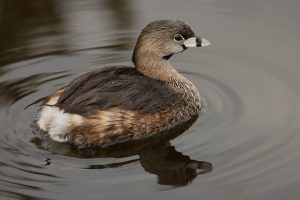
It is usually brown or gray in color. It has a short, blunt chicken-like bill, which in summer is encircled by a broad black band (hence the name). It is the only grebe that does not show a white wing patch in flight.
Piping Plover (Charadriusmelodus)
The Piping Plover is a small sand-colored, sparrow-sized shorebird that nests and feeds along coastal sand and gravel beaches in North America. The adult has yellow-orange legs, a black band across the forehead from eye to eye, and a black ring around the neck. This chest band is usually thicker in males during the breeding season, and it’s the only reliable way to tell the sexes apart. It is difficult to see when standing still as it blends well with open, sandy beach habitats. It typically runs in short starts and stops.
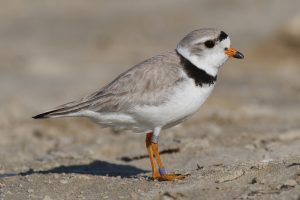
Roseate Spoonbill (Plataleaajaja)
The Roseate Spoonbill, sometimes separated in the monotypic genus (Ajaia), is a gregarious wading bird of the ibis and spoonbill family, Threskiornithidae. It is a resident breeder in South America mostly east of the Andes, and in coastal regions of the Caribbean, Central America, Mexico, and the Gulf Coast of the United States
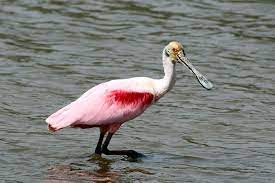
TX Hill Country Songbirds
Black-capped Chickadee
The Black-capped Chickadee has a black cap and bib with white sides to the face. Its under parts are white with rusty brown on the flanks and its back is gray. It has a short dark bill, short wings and a long tail. Males are larger. The tail is normally primarily slate-gray but has been observed in central New Jersey.
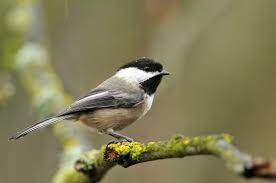
Black-capped Vireo (Vireo atricapilla)
The Black-capped Vireo is a small bird native to the United States and Mexico. It has been listed as an endangered species in the United States since 1987. The IUCN lists the species as vulnerable. The Black-capped Vireo is a songbird about 4.5 inches in length. Sexually mature males are olive green above and white below with faint yellow flanks.
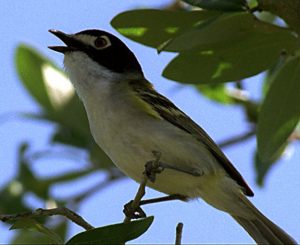
The crown and upper half of the head is black with a partial white eye-ring and lores. The iris is brownish-red and the bill is black. Females are duller in color than males and have a slate gray crown and underparts washed with greenish yellow. First year males are intermediate in coloration between adult males and females.
Eastern Bluebird (Sialia sialis)
The Eastern Bluebird is a small thrush found in open woodlands, farmlands and orchards, and most recently can be spotted in suburban areas. It is the state bird of Missouri and New York. Adults have a white belly.
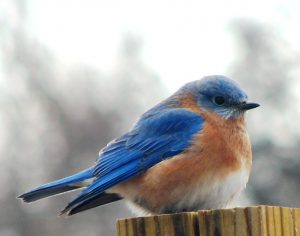
Adult males are bright blue on top and have a reddish brown throat and breast. Adult females have lighter blue wings and tail, a brownish throat and breast and a grey crown and back. Eastern Bluebirds are found east of the Rockies, southern Canada to the Gulf States and southeastern Arizona to Nicaragua.
Golden-cheeked Warbler (Dendroica chrysoparia)
The Golden-cheeked Warbler is an endangered species of bird that breeds in Central Texas, from Palo Pinto County southwestward along the eastern and southern edge of the Edwards Plateau to Kinney County. The Golden-cheeked Warbler is the only bird species with a breeding range confined to Texas. Golden-cheeked warblers nest in ashe juniper and live oak trees in ravines and canyons.
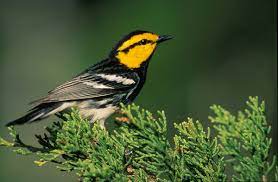
They use bark and spider webs to build their nests. Females lay three to four eggs. Warblers eat insects and spiders and the adult warbler can reach a length of 4.5 inches. They winter in southern Mexico (Chiapas), Guatemala, Honduras, and Nicaragua.
Lesser Goldfinch
The Lesser Goldfinch or Dark-backed Goldfinch is a very small songbird of the Americas. Together with its relatives the American Goldfinch and Lawrence’s Goldfinch, it forms the American goldfinches clade.
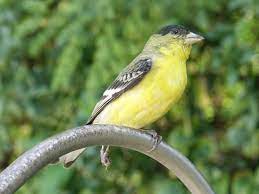
American goldfinches can be distinguished by the males having a black (rarely green) forehead, whereas the latter is (like the rest of the face) red or yellow in the European Goldfinch and its relatives. North American males are markedly polymorphic and 5 subspecies are often named; at least 2 of them seem to represent a less-progressed stage in evolution, however.
Northern Cardinal
The Northern Cardinal or Redbird or Common Cardinal is a North American bird in the genus Cardinalis. It can be found in southern Canada, through the eastern United States from Maine to Texas and south through Mexico. It can also be found on the Big Island of Hawaii and on Oahu. It is found in woodlands, gardens, shrublands, and swamps.
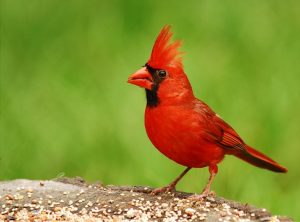
The Northern Cardinal is a mid-sized songbird with a body length of 21 centimeters. It has a distinctive crest on the head and a mask on the face which is black in the male and gray in the female. The male is a vibrant red, while the female is a dull red-brown shade.
Northern Mockingbird (Mimuspolyglottos)
The Northern Mockingbird is the only mockingbird commonly found in North America. This species was first described by Linnaeus in his Systema naturae in 1758 as Turdus polyglottos. The Northern Mockingbird breeds in southeastern Canada, the United States, northern Mexico, the Bahamas, the Cayman Islands and the Greater Antilles.
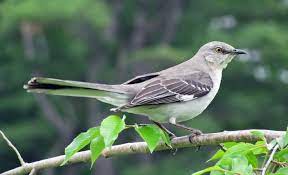
It is replaced further south by its closest living relative, the Tropical Mockingbird. The Socorro Mockingbird, an endangered species, is also closely related, contrary to previous opinion. The bird is the state bird of Arkansas, Florida, Mississippi, Tennessee and Texas. This bird is mainly a permanent resident, but northern birds may move south during harsh weather. This species has occurred in Europe as an extreme rarity.
Painted Bunting (Passerinaciris)
The Painted Bunting is a species of bird in the Cardinal family, Cardinalidae, that is native to North America. The male Painted Bunting is often described as the most beautiful bird in North America. Its beautiful colors, dark blue head, green back, red rump and underparts, make it easy to identify, but is difficult to spot since it hides in foliage even when it sings. The plumage of female and juvenile Painted Buntings is green and yellow-green, serving as camouflage.
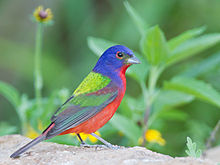
Pine Warbler (Dendroica pinus)
The Pine Warbler is a small songbird of the New World warbler family. These birds have white bellies, white wing bars, dark legs and thin, relatively long pointed bills; they have yellowish lines over their eyes. Adult males have olive upperparts and bright yellow throats and breasts; females and immatures display upperparts which are olive-brown. Their throats and breasts are paler.
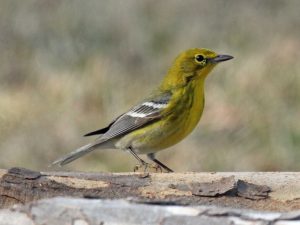
Tufted Titmouse
The Tufted Titmouse is a small songbird from North America, a species in the tit and chickadee family
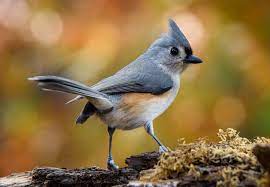
Texas Hill Country Sparrows
House Sparrow
The House Sparrow is a species of passerine bird of the sparrow family Passeridae. It occurs naturally in most of Europe, the Mediterranean region, and much of Asia. It has also been intentionally or accidentally introduced to many parts of the world, making it the most widely distributed wild bird. It is strongly associated with human habitations, but it is not the only sparrow species found near houses. It is a small bird, with feathers mostly different shades of brown and grey.

Swallows in TX Hill Country
Barn Swallow
The Barn Swallow is the most widespread species of swallow in the world. A distinctive passerine bird with blue upperparts, a long, deeply forked tail and curved, pointed wings, it is found in Europe, Asia, Africa and the Americas. In Anglophone Europe it is just called the Swallow; in Northern Europe it is the only common species called a “swallow” rather than a “martin”.
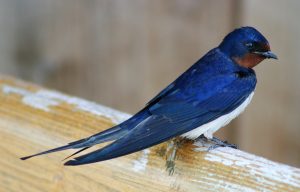
Central Texas Swifts
Chimney Swift (Chaeturapelagica)
The Chimney Swift is a small swift. In flight, this bird looks like a flying cigar with long slender curved wings. The plumage is a sooty grey-brown; the throat, breast, underwings and rump are paler. They have short tails.
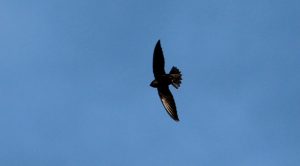
Wild Turkey in Dropping Springs
Turkey
A turkey is either of two or three living species of large birds in the genus Meleagris. One species commonly known as the Wild Turkey, is native to the forests of North America.
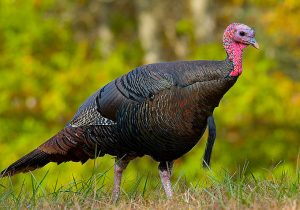
Vultures in Texas
Black Vulture
The Black Vulture, also known as the American Black Vulture, is a bird in the New World vulture family whose range extends from the southeastern United States to Central Chile and Uruguay in South America. Although a common and widespread species, it has a somewhat more restricted distribution than its compatriot, the Turkey Vulture, which breeds well into Canada and south to Tierra del Fuego. The Black Vulture is a scavenger and feeds on carrion, but will also eat eggs orkill newborn animals. In areas populated by humans, it also feeds at garbage dumps. It finds its meals either by using its keen eyesight or by following other (New World) vultures, which possess a keen sense of smell.
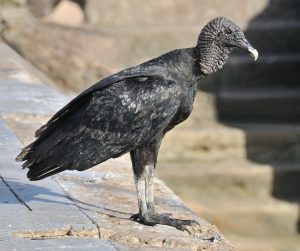
Turkey Vulture
The Turkey Vulture is a bird found throughout most of the Americas. It also known in some North American regions as the Turkey Buzzard (or just Buzzard), and in some areas of the Caribbean as the John Crow or Carrion Crow. The Turkey Vulture is a scavenger and feeds almost exclusively on carrion. It finds its meals using its keen vision and sense of smell, flying low enough to detect the gasses produced by the beginnings of the process of decay in dead animals. In flight, it uses thermals to move through the air, flapping its wings infrequently. It roosts in large community groups.
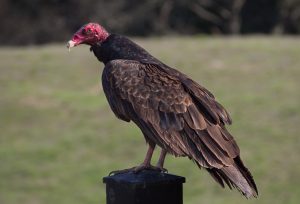
Woodpeckers in TX Hill Country
Downy Woodpecker (Picoidespubescens)
The Downy Woodpecker is the smallest woodpecker in North America. Adults are mainly black on the upper parts and wings, with a white back, throat and belly and white spotting on the wings. There is a white bar above the eye and one below. They have a black tail with white outer feathers barred with black. Adult males have a red patch on the back of the head whereas juvenile birds display a red cap.

Ladder Back Woodpecker
The Ladder-backed Woodpecker is fairly common in dry brushy areas and thickets and has a rather large range. It can be found year-round over the southwestern United States, most of Mexico, and locally in Central America as far south as Nicaragua.
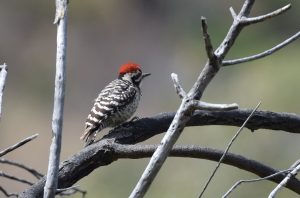
Northern Flicker (Colaptesauratus)
The Northern Flicker is a medium-sized member of the woodpecker family. It is native to most of North America, parts of Central America, Cuba, the Cayman Islands, and is one of the few woodpecker species that migrate. It is the only woodpecker that commonly feeds on the ground. There are over 100 common names for the Northern Flicker. Among them are: Yellowhammer, clape, gaffer woodpecker, harry-wicket, heigh-ho, wake-up, walk-up, wick-up, yarrup, and gawkerbird. Many of these names are attempts at imitating some of its calls.

Red-bellied Woodpecker (Melanerpes carolinus)
The Red-bellied Woodpecker is a medium-sized woodpecker of the Picidae family. It breeds in southern Canada and the northeastern United States, ranging as far south as Florida and as far west as Texas. Its common name is somewhat misleading, as the most prominent red part of its plumage is on the head; the Red-headed Woodpecker however is another species that is a rather close relative but looks entirely different. Adults are mainly light gray on the face and underparts; they have black and white barred patterns on their back, wings and tail. Adult males have a red cap going from the bill to the nape; females have a red patch on the nape and another above the bill. The reddish tinge on the belly that gives the bird its name is difficult to see in field identification.

Red-cockaded Woodpecker (Picoides borealis)
About the size of the Northern Cardinal, the Red-cockaded Woodpecker is approximately 8.5 in. long, with a wingspan of about 14 in. and a weight of about 1.5 ounces. Its back is barred with black and white horizontal stripes. The Red-cockaded Woodpecker’s most distinguishing feature is a black cap and nape that encircle large white cheek patches. Rarely visible, except perhaps during the breeding season and periods of territorial defense, the male has a small red streak on each side of its black cap called a cockade, hence its name. The Red-cockaded Woodpecker feeds primarily on ants, beetles, cockroaches, caterpillars, wood-boring insects, and spiders, and occasionally fruit and berries.
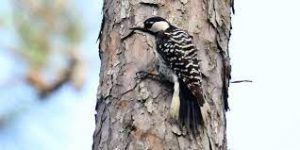
Wrens in Central Texas
Carolina Wren
The Carolina Wren is a common species of wren, resident in the eastern half of the USA, the extreme south of Ontario, Canada, and the extreme northeast of Mexico. A distinct population in the Yucatan Peninsula of Mexico, Belize and extreme north of Guatemala.
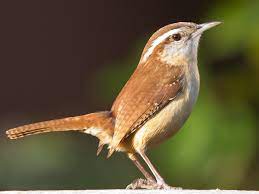
House Wren
The House Wren is a very small songbird of the wren family that occurs from Canada to southernmost South America. In most suburban areas in its range it is the single most common wren.
